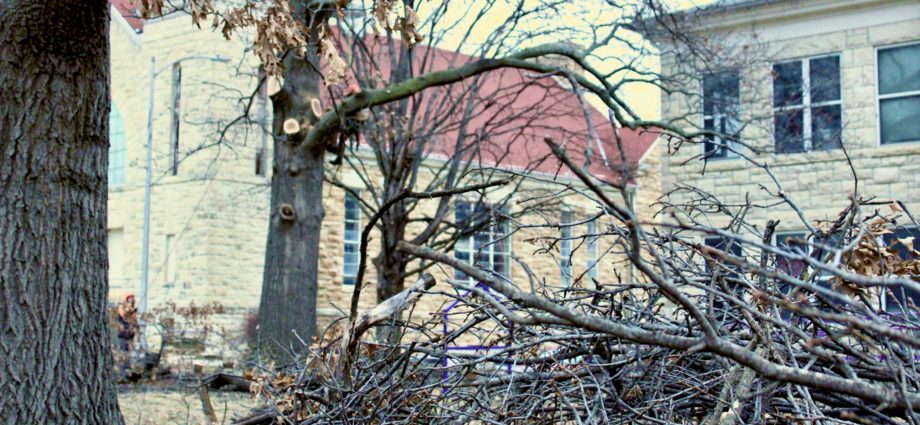As you were on your way to class in the first week of February, you may have noticed numerous aerial lift trucks and tree chippers hard at work. The commotion was hard to miss. The Kansas Tree Care (KTC) company was commissioned to remove and trim various trees on Haskell Indian Nations University (HINU) campus. It begs the question as to the reasoning behind such a decision; at first glance, it may not seem like they even needed to be removed. For various reasons, there were 7 trees in total that were taken down. The professional arborists at KTC have provided substantial insight into the root of the problem.
Kenny Flanders, a Haskell alumnus, was one of the workers from KTC. He was able to clarify why trimming and cutting down certain campus trees was necessary. The biggest issue was the impact of the emerald ash borer on white ash trees. Originating in Asia, this beetle found its way to Michigan in 2002 through shipments and eventually made its way to 33 states and several territories in Canada — killing millions of white ash on the way. Unfortunately, there are no viable means to bring back a tree already infected with this beetle. Flanders spoke about the condition of the trees behind Pocahontas Hall saying, “…the top branches were visibly decaying”. From a visible inspection of the pile of wood, there is evidence of extensive rotting. The emerald ash borer has no natural predators on Turtle Island. It became obvious that these white ash trees were going to meet their demise sooner or later.
Besides being cut down, many trees were also trimmed. Flanders also spoke about the importance of tree trimming in late winter. “This is usually to slow or stop the spreading of any diseases the trees may have been infected with and even to help the tree maximize their resources”. Essentially, the water and nutrients that would have gone to the decaying branches can now be used much more efficiently throughout the whole tree. KTC plans to come back in a month to trim more.
The other trees that were taken down were considered hazards to either pedestrians or buildings. For instance, the tree in front of Sequoyah Hall was severely damaged from a fungus. Professor Tyler Kimbrell, who was a crucial decision-maker for this project, called the tree a “hotel for squirrels”, speaking about the extent of the damage. Since this is an area where students and faculty frequently walk, there was no question on the fate of this tree. A few healthy trees by Coffin Complex were also taken down but for a different reasons; their proximity imposed a risk to the integrity of the building because of how close they were allowed to grow to it.
Now that these trees are taken down, they are considered resources for the HINU campus to utilize. In fact, Kimbrell expressed how this was part of the plan: for the wood to be repurposed to enrich the culture here on campus.
One of the obvious ways to use the wood is for fires. The fire pit in front of the Auditorium can directly benefit. Some other ways the campus can use the firewood is for sweat lodges and even Native American Church services. It was made clear that with collaborative planning and predetermined intention, the wood can have boundless uses.
For instance, some of the thicker logs are being dried out so they can be turned into drums. Drums Kimbrell hopes can be in use at HINU for years to come. He also anticipates other projects that could require some logs to be turned into lumber. One proposed project is raised garden beds for medicinal and vegetable plants, a project currently in the planning phase.
All that remains is the question on the replacement of the fallen trees or if they should be replaced at all. Kimbrell expressed the desire for there to be a geographic representation of the many tribal students that attend HINU. This would entail reaching out to tribal communities to potentially have trees from various geographic areas. Yet, there are also many native Kansas trees that can be propagated. These trees would have the best chance of thriving in the clayey soil type of eastern Kansas. After all, much of the reason trees start to decay is because the trees were stressed in some way. Whatever the decision, it is of utter importance we be mindful of the implications.
Overall, it is sad to see our elders leaving, yet their legacy will not just be embers in the wind. It is our responsibility to make sure that is not the case. The re-purposing of the ones who have looked down upon us will, without a doubt, enrich our HINU experience. The framework for the re-purposing of decaying trees can be implemented in the future when others eventually meet their demise. Yet it is even more important to care for the ones that are still standing because many times the damage can be mitigated or even avoided altogether. The next time you come across a campus tree (or any, for that matter), remember to embody graciousness in their predetermined presence.
I solemnly acknowledge Tyler Kimbrell’s leadership and planning in ensuring these trees were taken care of in a respectful way.

